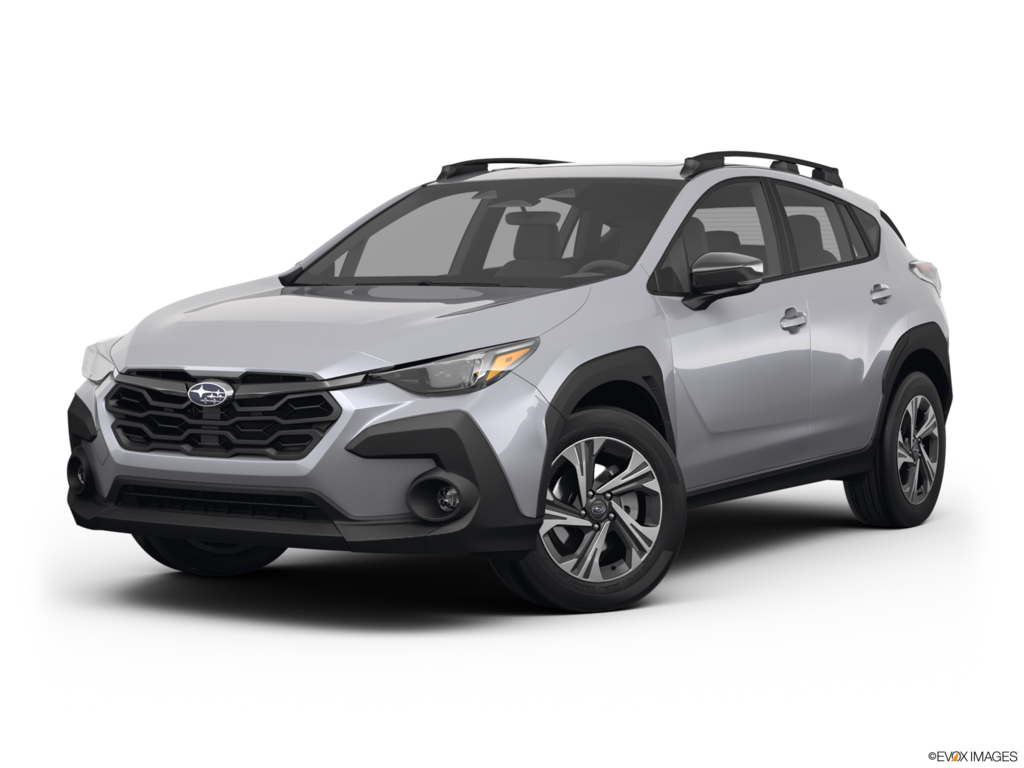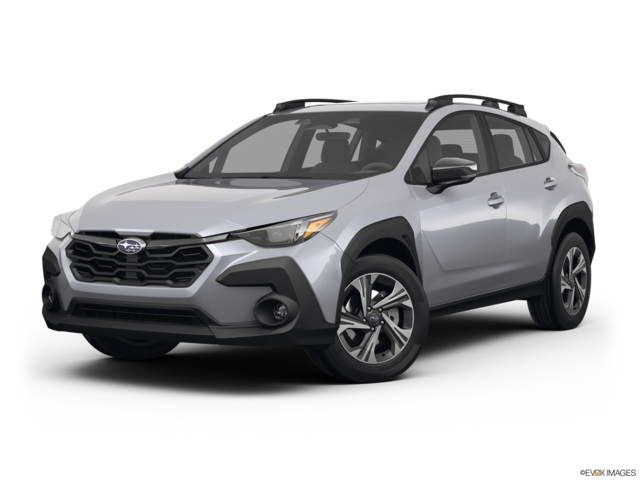
Third generation Subaru Crosstrek
The third-generation Subaru Crosstrek came to market with familiar styling combined with more rugged design cues. The exception is the all-new Crosstrek Wilderness, sporting unique styling, off-road tires, and 9.3 inches of ground clearance. All third-generation Crosstreks ride on Subaru’s updated global platform for improved handling and ride comfort.
All but the base-level Crosstrek received a new 11.6-inch vertical touchscreen display running Subaru’s intuitive infotainment system. Subaru also updated its EyeSight® driver-assist system to improve performance in a wider range of road and weather conditions, while automatic emergency steering was added to the extensive driver-assist feature list.
The Crosstrek's engines were carried over from the previous generation; however, the more powerful 2.5-liter engine was revised to deliver slightly more torque for improved responsiveness. Subaru discontinued the manual transmission for this generation, and all variants use a continuously variable transmission (CVT). Like all prior generations, the Crosstrek comes standard with all-wheel drive.
Model highlights
New Wilderness trim
Manual transmission discontinued
Revised 2.5-liter engine
Improved driver-assist systems
Updated X-MODE® off-road system
Second generation Subaru Crosstrek
A year after Subaru introduced a new Impreza, the second-generation Crosstrek joined the lineup, built on the same new Subaru Global Platform as its smaller sibling. Slightly longer and wider than the previous version, the updated Crosstrek stood out from the first generation with larger fender flares, stylish new headlights, and a revised grille.
More interior space and an updated infotainment system with a new eight-inch touchscreen were significant improvements from the previous version, with Apple CarPlay® and Android Auto™ added as standard features. The next-gen Crosstrek was also equipped with X-MODE® for improved off-road capability.
The standard 2.0-liter engine received a slight power bump from the previous generation, and it was available with a new six-speed manual gearbox or an updated Lineartronic CVT. In 2019, Subaru added a plug-in hybrid version of the Crosstrek with 17 miles of electric-only driving. A more powerful 2.5-liter engine was added as an option a few years later.
Model highlights
New infotainment with Android Auto™/Apple CarPlay®
X-MODE® off-road system
Added driver-assist features
Plug-in hybrid option (added in 2019)
More powerful 2.5-liter engine (added in 2021)
Fifth generation Subaru Crosstrek
This popular crossover was initially called the XV Crosstrek when the first generation launched in 2013–the XV was removed from the name for the 2016 model year. Following the same formula Subaru used when converting the Legacy wagon to the Outback, the XV Crosstrek was basically an Impreza with an additional three inches of ground clearance, upgraded suspension, and rugged styling.
The first gen XV Crosstrek came standard with the same 2.0-liter engine found in the Impreza, along with a five-speed manual transmission and all-wheel drive. In 2014, the Crosstrek became the first hybrid in Subaru's lineup–it had slightly more horsepower, but with the required battery pack adding significant weight, the hybrid's performance and fuel economy were not dramatically improved over the standard model.
With a plain but functional cabin, the XV Crosstrek had enough room for full-size front and rear passengers, as well as a spacious cargo area. An available 6.1-inch touchscreen navigation system included a rearview camera, and Subaru’s EyeSight® driver-assist system became available in 2015.
Model highlights
New model, replacing Impreza Outback Sport
First Subaru hybrid (added in 2014)
EyeSight® driver-assist system (added in 2015)
Raised ground clearance, standard all-wheel drive
Available 6.1-inch touchscreen
Changes by year
Latest generation from 2024 - present
2025 Subaru Crosstrek

Highlights
Premium trim gets a more powerful engine
Premium Trims get hill descent control added to X-MODE®
Learn more
2024 Subaru Crosstrek

Highlights
Redesigned with updated styling and technology features
New Wilderness trim
Manual transmission discontinued
Learn more
Previous generation from 2018 - 2023
2023 Subaru Crosstrek

2022 Subaru Crosstrek

2021 Subaru Crosstrek

Highlights
New, more powerful 2.5-liter engine
Refreshed front styling
Added driver-assist features
Learn more
2020 Subaru Crosstrek

Highlights
New LED exterior lighting
More standard features, including engine stop-start
Learn more
2019 Subaru Crosstrek

2018 Subaru Crosstrek

Previous generation from 2013 - 2017
2017 Subaru Crosstrek

2016 Subaru Crosstrek

Highlights
Name changes from XV Crosstrek to just Crosstrek
Mild styling update
New STARLINK® telematics
Learn more
2015 Subaru Crosstrek

Highlights
New base trim level
Standard rearview camera
Available Subaru EyeSight® advanced driver-assistance system
Available seven-inch touchscreen display
Learn more
2014 Subaru Crosstrek

Highlights
Hybrid powertrain added to the lineup
Smartphone integration available
Learn more
2013 Subaru Crosstrek

Highlights
The XV Crosstrek was an all-new model for 2013
Increased ride height for off-road capability
2.0-liter four-cylinder engine
CVT automatic or manual transmission
Learn more
Looking for 2012 models or older?
CarMax only sells 2013 models and newer. But no matter the year, we'll happily buy your car.
Reliability
RepairPal gave the Subaru Crosstrek an overall reliability rating of 4.5 out of 5 stars, which RepairPal describes as Excellent. This rating ranks Subaru Crosstrek 5th out of 29 among Compact SUVs.
RepairPal reports that the average total annual cost for repairs and maintenance on a Subaru Crosstrek is $456, compared to an average of $473 for Compact SUVs and $591 for all the vehicles RepairPal considered in its dataset.
According to RepairPal, Subaru Crosstrek owners bring their vehicles into a repair shop for unscheduled repairs an average of 0.4 times per year, compared to an average of 1.0 times for Compact SUVs and 1.3 times for all the vehicles RepairPal considered in its dataset.
RepairPal reported that the probability of a repair being a severe or major issue is 10% for the Subaru Crosstrek, compared to an average of 13% for Compact SUVs and 14% for all the vehicles RepairPal considered in its dataset.
We hope you found this information helpful. This content is intended to inform and is not meant to provide legal, financial or investment advice. We make every effort to provide accurate information, but please verify before transacting and consider talking to a qualified professional about your unique circumstances.
Statements of fuel economy or EV range are based on EPA and other third-party estimates for vehicles when new. Fuel economy and EV range will degrade with time and vary based on age, driving conditions, vehicle history, and other conditions. See fueleconomy.gov for more info.
Editorial content contained on this page comes from Edmunds.com, Inc., a subsidiary of CarMax Enterprise Service, LLC, and information related to featured vehicles comes from third-party sources, including manufacturer information. Product and company names may be trademarks or registered trademarks of third-party entities. Use of them does not imply any affiliation with or endorsement by these entities. By clicking on any video links, you will be taken to a third-party site maintained by YouTube, Inc.


